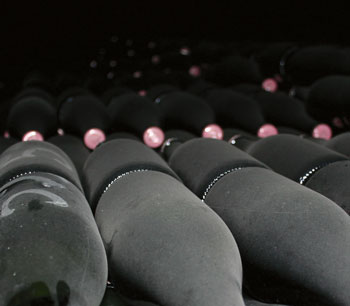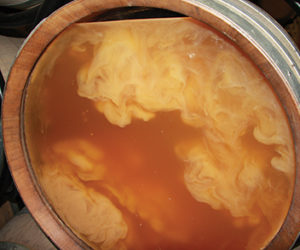 Discussions of wine aging range well into the past, from the biblical story of Luke and putting new wine into old skins, to the ancient Roman interest in Falernian wine, which could age for 20 years (or more). Certain wines can improve with extended storage time, but there are a lot of incomplete ideas and misconceptions about wine aging. What really happens to the wine in the carboy, barrel and bottle, and the role of sulphite and storage conditions is often misunderstood. With kit wines in particular, I get asked a lot of questions about the potential for aging — the most common question is “how long will my wine last once I bottle it?”
Discussions of wine aging range well into the past, from the biblical story of Luke and putting new wine into old skins, to the ancient Roman interest in Falernian wine, which could age for 20 years (or more). Certain wines can improve with extended storage time, but there are a lot of incomplete ideas and misconceptions about wine aging. What really happens to the wine in the carboy, barrel and bottle, and the role of sulphite and storage conditions is often misunderstood. With kit wines in particular, I get asked a lot of questions about the potential for aging — the most common question is “how long will my wine last once I bottle it?”
The truth is, kit wine will age similarly and as well as most wines made from grapes. The most important factor, other than the integrity of the wine in the bottle, is how the bottle is stored. If you keep a decent wine in a cave at 52 ºF (10 ºC) with 60-80% humidity, zero light or vibration, seal it with a quality cork and never move or disturb it, it will last a couple of decades without spoiling. However, inappropriate temperature, vibration, low humidity and change or variance in these conditions will affect your wine negatively.
Making Sure Your Kit Wine is Ready
For the purpose of this article, we’re interested in your wine after fermentation — after clearing has finished and the wine is stable and in the bottle, carboy or barrel. If you do intend to age your kit wine, make sure it has between 35 and 50 PPM (parts per million) of free sulphur dioxide (FSO2) when you’re ready to bottle. FSO2 decreases over time and becomes “bound” SO2 that is no longer able to protect the wine from oxidation or bacterial spoilage. Some kits already contain adequate sulphite powder in their additive packs to ensure this level, while others have a more conservative amount. The good news is, the ones that have a lower level all have a note in the instructions at the bottling stage that reads something like “If you intend to age your kit more than six months, please add an extra one-quarter teaspoon of metabisulphite powder to the wine before bottling.”
The question immediately comes up: if 35–50 PPM is the right level, why not just include that in the package? It seems that traditionally, people who made kits drank them fairly quickly, and with the advent of “wine-on-premise” (shops where you can make your wine on site and take it home after bottling) manufacturers saw the rise of “trunk-aging.” That is, if you caught an on-premise winemaker loading his cases into the trunk of his car and asked how long he intended to age his wine, the answer might well be, “about three miles.” In order to leave these quick-consumers a choice about the sulphite levels in their wine, some manufacturers left it low — you can always add more later, but you can’t get it out once it’s in the wine. If you’re in doubt about your kit sulphite levels, either follow the manufacturer’s instructions or get a sulphite-testing kit and check your levels — nobody ever spoiled their wine by doing too much testing and checking.
Bulk or bottle?
One thing that comes up fairly often is the idea that aging in bulk in the carboy will produce better wine. Well . . . no. Once the wine is completely clear and stable, carboys don’t present an advantage for medium-term storage over bottles. There is no magic chemical process that is aided by storing it in a larger volume. If you think about it, wineries work to get their wines stable and ready, and then as soon as they are, they put them into bottles to finish aging — no ifs or buts, it’s bottles. In fact, the modern concept of aging wine only came about in the 1600’s after the adoption of bottles and corks for wine storage.
However, there are two small things that can be cast as votes in favor of bulk-aging. First, if your aging/cellaring area goes through a lot of temperature swings then the larger bulk of a 6-gallon (23-L) carboy will provide more thermal mass to ride out the temperature shifts, preventing sudden thermal shocks to the wine.
Second, if your wine is resting quietly in a nicely topped-up carboy, there’s no way to sneak a bottle to see if it’s ready. This can be a challenge to wine connoisseurs as well as home winemakers. My friend Chris, an award-winning sommelier actually stores his best bottles at his parent’s house, a three-hour drive from his own. He explains that his strategy is to prevent the sudden “Friday-night-after-dinner-and-a-few-bottles” notion of digging into the cellar to try his treasures. If you have trouble keeping your mitts off wine that might not yet be ready, a carboy can be a powerful tool to prevent “vinfanticide.” If you’ve got the willpower, go ahead and bottle.
Acceptable Cellaring Conditions in the Average Home
Temperature
Cool temperatures prevent heat damage (browning and oxidation) and keep the aging process at a reasonable pace (about 55–65 °F or 12–17 ºC). Below this range, wine will age very slowly, and above it, wine will age more rapidly. If you can’t put your wine in an area cooler than this, don’t worry: anything below 70 ºF (22 ºC) is reasonable for at least a year or two of aging, if the humidity isn’t too low, and the temperature doesn’t fluctuate.
Consistent Temperature
Fluctuations in climate are much more damaging than high temperatures. When wine heats and cools, it expands and contracts inside the bottle. Because the bottle isn’t changing size, this means the wine will be pushing and pulling against the cork and will either push it out of the bottle, leak or start drawing oxygen — any of which will result in ruined wine in very short order. Your cellar should have less than a 10 ºF (5 ºC) seasonal variation from summer to winter and less than a 3 ºF (1.5 ºC) variation over the course of a day.
Humidity
Seventy percent humidity is ideal for most wines, but anything between 60–80% will suffice. Humidity over 80% can encourage mold, which will attack corks and ruin labels. Humidity under 60% will cause corks to dry, allowing evaporation and oxidation.
Darkness
Direct, bright light exposure (such as direct sunshine or glaring spotlights) can cause protein hazes and off aromas. Fortunately most household lighting isn’t that powerful. When given the choice, darker is always preferable to lighter.
Vibration
Surprisingly, this one is a problem — vibration, whether from appliances or that railroad junction outside the living room window, can shake the wine so badly that some of the aging processes don’t work, and the wine simply falls apart.
Odors
Most people don’t store paint or gasoline in their refrigerator for the reason that the volatiles and solvents in petrochemicals, cleaning agents and household chemicals would rapidly taint food, rendering it inedible. The same thing could happen to your wine, if it becomes exposed to volatiles or other stinky chemicals. The place in most houses where odorous chemicals are stored is the basement.
Here are a few tips on battling aging problems:
Temperature fluctuations
Minimize the impact of temperature changes by keeping the wine up against a north-facing wall. Sunlight striking the foundation or the earth around it can cause a temperature flux. Also, you might want to build an enclosure around your wine rack if it’s out in the open — this can help diminish convection currents and increase thermal inertia. It doesn’t have to be fancy if you’re not a handyman. I’ve constructed temperature enclosures out of Tyvek (the foam-board house insulating material), duct-tape and corner brackets.
Lack of humidity
In colder, drier climates like the north and midwest, humidity can drop quite low, especially in winter. Too low and your corks will dry out, allowing oxidation and, potentially, leakage. Humidifiers sold for home use are not a good answer — they work too well and can cause a build-up of mold and mildew in places like the basement, where air circulation is low. It makes more sense to set up a passive humidifier. Essentially this is a pan of water, a clean dishcloth and a cinderblock. Set the pan of water on top of the cinderblock in your cellar, drape the dishcloth half-in and half-out of the pan and tuck the bottom end on top of the block. This will allow the towel to wick the moisture out of the pan and increase the evaporation into the air. The cinder block will hold any excess moisture and release it slowly, helping keep the humidity steady, even in a cellaring area as big as 10 ft. x10 ft.
Cellaring wine used to be a rich man’s game. Other than wine merchants storing stock for future sale, only the highly wealthy could afford to purchase age-worthy wines in large volumes and then wait as the years passed to sample them as they approached their peak. The French used to say that you didn’t buy Bordeaux for yourself, you bought it for your children, while you drank the wine your father
had bought.
Now we home winemakers can do it, simply, easily and a lot more cost-effectively than our predecessors. With kits, you can age a wide range of varietals and styles, from growing regions around the world. It can even have a sense of poetry about it, following your wine down the years, watching it evolve, tasting the changes and appreciating the ebb and flow of time. However, you shouldn’t wait too long. As Theophile Malvezin said, “Wine is made to be drunk as women are made to be loved; profit by the freshness of youth or the splendor of maturity; do not await decrepitude.”







